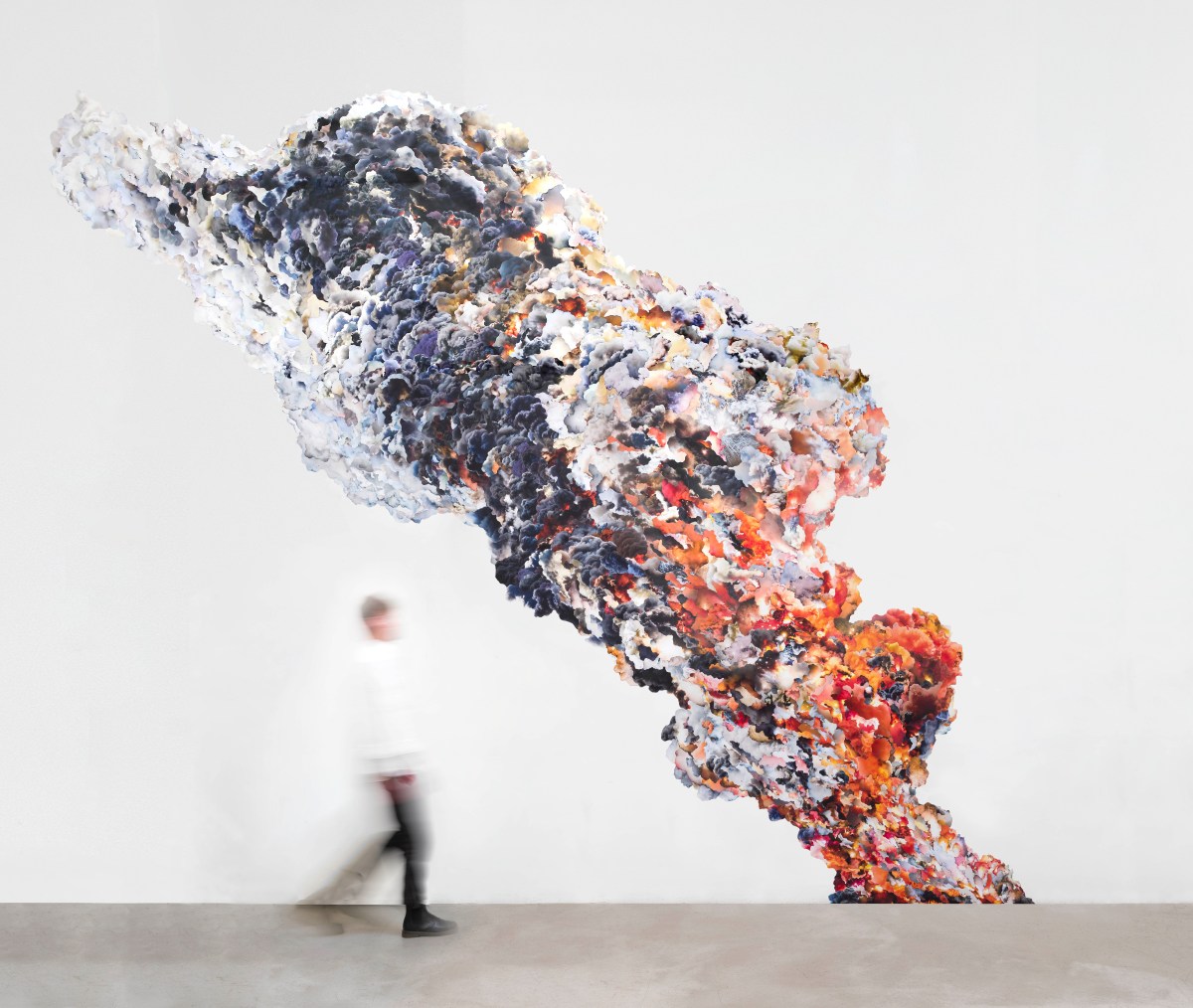The new exhibition, Air, from the Queensland Art Gallery | Gallery of Modern Art (QAGOMA) in Brisbane is a thematic sequel to Water presented in the summer of 2019-20. That exhibition was unfortunately cut short due to the onset of COVID, but still attracted over 120,000 viewers.
In introducing Air at the launch on 25 November, QAGOMA Director Chris Saines said: ‘Air reverberates with currency and timeliness. It explores the cultural, ecological and social justice dimensions of the air we all breathe.’
This exhibition includes diverse works from 30 leading international and Australian artists, with many newly commissioned pieces and the addition of pertinent works from the collection. Presented in a range of media from monumental immersive installations to intimately scaled objects, the exhibition traverses the entire ground floor of GOMA.
Geraldine Kirrihi Barlow, QAGOMA’s Curatorial Manager of International Art, said: ‘At this moment in history, as global temperatures rise, we are sensitive to air as never before: alert to airborne threats and aware of our reliance on this precious mix of gases.’
She continued: ‘The exhibition asks us to consider the air we share with all other life, to reflect on what it means to breathe freely and to examine air as a metaphor for change and the realisation of our potential.’
Saines added: ‘Through five unfolding chapters – Atmosphere, Shared, Burn, Invisible and Change – the work of contemporary artists will inspire visitors to consider the global environmental and social challenges we face, including sustainability, equity and connectivity.’
Atmosphere
A huge installation greets one on arrival in GOMA’s central atrium. A major new commission by Argentinian artist Tomás Saraceno, Drift: A cosmic web of thermodynamic rhythms 2022, is one of his most ambitious works. Both poetic and symbolic, a constellation comprises 15 large partially-mirrored and reflective spheres, which float at different heights. Like celestial bodies breathing gently in an infinite space, these orbs are a mesmerising and impactful work. Drift dominates the light-filled space with a calming influence.
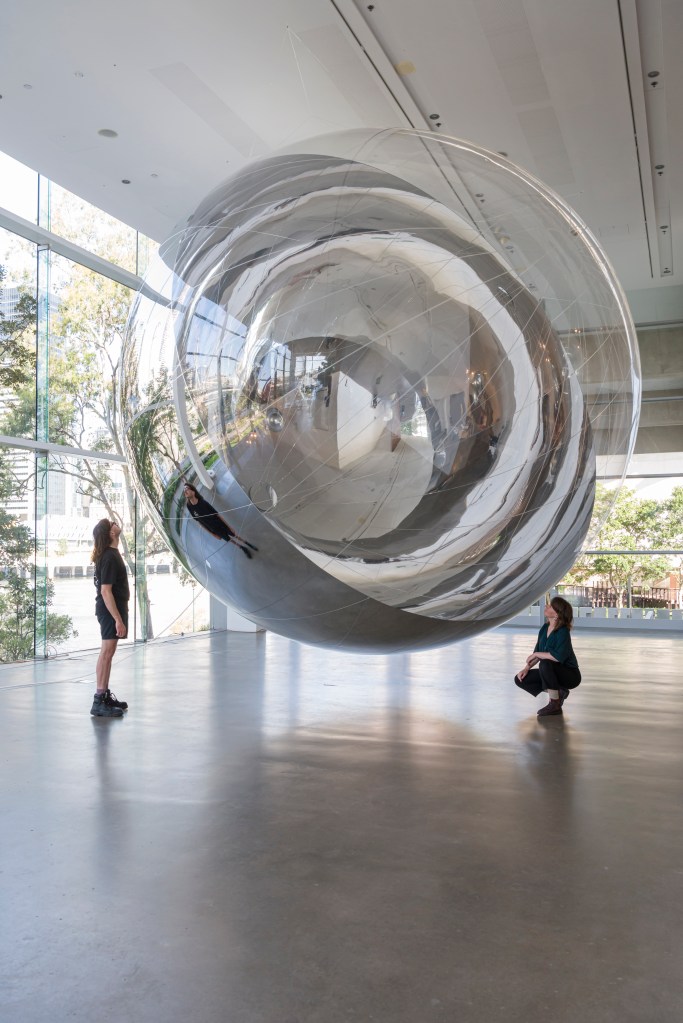
Croatian artist Dora Budor’s Origins 1-111 2019 starts its life at the bottom of a primordial ocean from where our world emerged. She gives us a trio of glass chambers evoking Earth’s earliest days with its undulating mounds of dust. Clearly not an atmosphere we would wish to breathe in, but one that perhaps is a timely reminder of today’s world.
Shared
This theme looks more closely at how we share the air, in particular with flora and organic life. It includes Lloyd Rees’ group of tree studies, Albert Namatjira’s Corymbia aparrerinja and Rosslynd Piggott’s collection of 65 small bottles, all with samples of air. Additionally, Katie Paterson’s To Burn, Forest, Fire 2022 offers a meditative artwork where two sticks of incense create distinctive and different forest smells.
Australian sculptor Jamie North is influenced by his collective interest in both native plant communities and industrial ruins. His commissioned work, Portal 2022, has twin decaying concrete columns that feature plant species indigenous to Brisbane. The columns are offset yet partly face each other. The artist tells ArtsHub: ‘These are a pair of works that function like a set of lungs within the space. The participant can move around and stand between the works and experience that exchange of gases.’ It is a dynamic work depicting nature under threat, but also exploring how humans can find better ways in which to co-habit with the natural world.
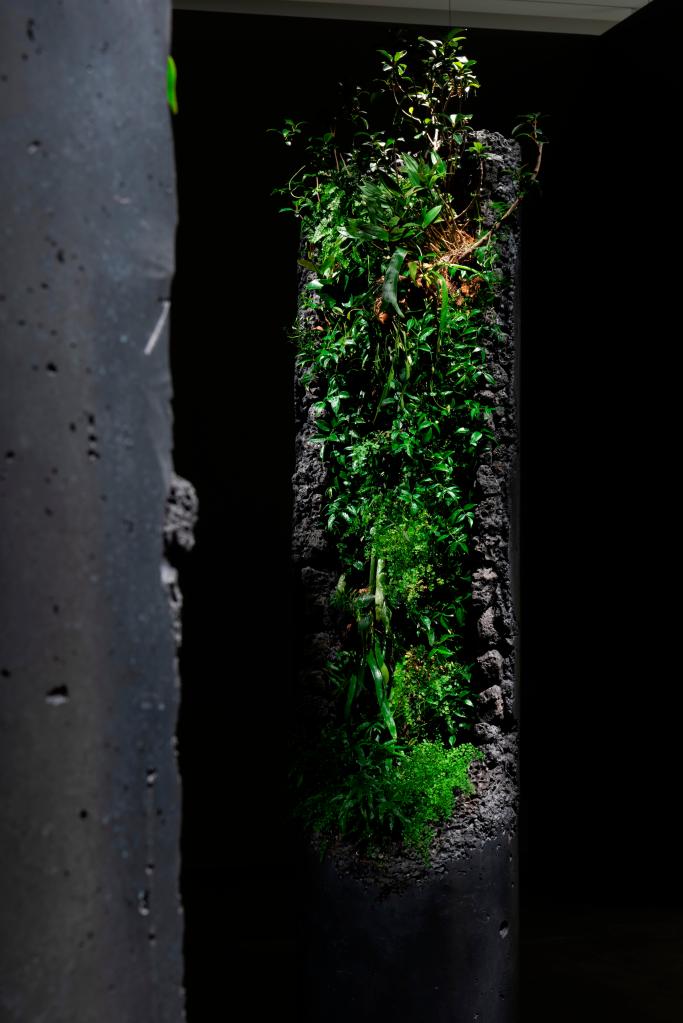
Burn
Palestinian-British artist, Mona Hatoum’s stunning orange-red neon-lit sculpture Hot Spot depicts a world burning dangerously and with political turmoil. Created in 2006, it is even more relevant today as it so aptly describes our ecological crisis, alongside the competition for resources and man’s endless wars and conflicts. A powerful and relevant work.
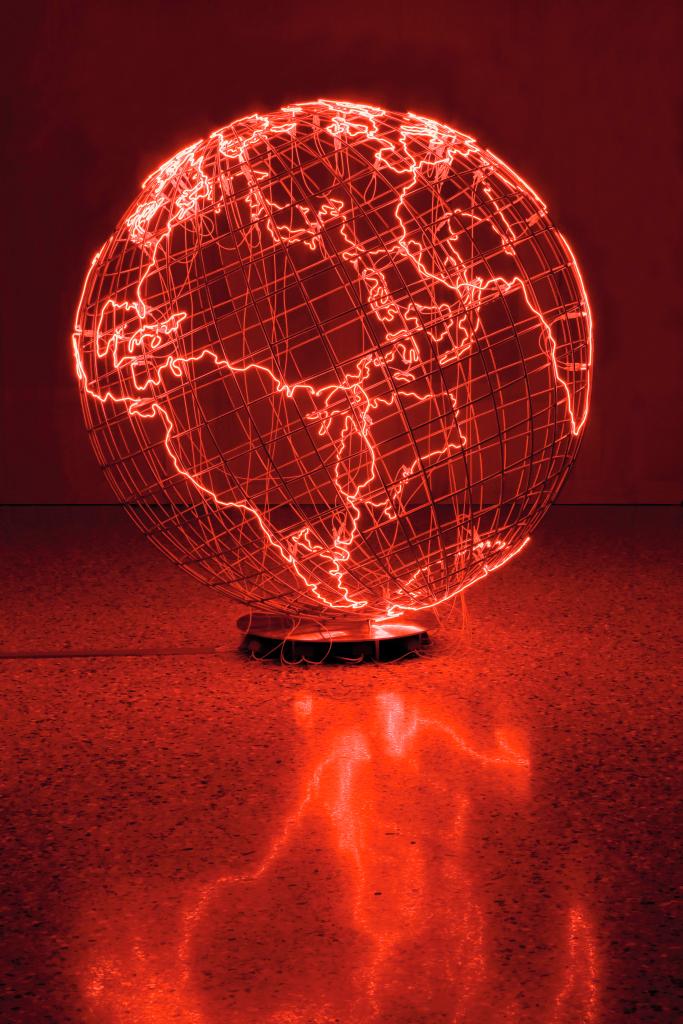
US artist Nancy Holt created a series of works in the 1980s and 90s that explored industrial systems and included ventilation, oil and electricity. Her sprawling Ventilation Systems is aptly included in Air, as we become evermore aware of the interconnectedness of global supply chains in particular with relation to oil and energy.
It is matched by two films that explore the wider themes of our industrial and consumer-hungry society. Iraqi-British artist Jananne Al-Ani traces structural industrial relationships in her film, Black Powder Peninsula 2016, while Swiss artists, Peter Fischli and David Weiss’ iconic 1987 film The Way Things Go explores cause-and-effect design systems. Both are stimulating and thoughtful.
Invisible
Australian-British artist, Ron Mueck’s over life-sized sculpture In Bed 2005 is disturbingly familiar as we can all recognise the anxiety and fear that many felt during COVID lockdowns. There was a need to retreat to the security of one’s bed and become invisible to the world, as this work so aptly demonstrates.
Rachel Mounsey, an Australian photojournalist who lives in Mallacoota, eastern Victoria, was home and able to document the Black Summer bushfires in 2019/20. QAGOMA has purchased several of her amazing photographs for this exhibition and its collection. They depict the red and brown colours of the burnt landscape and the dull orange and amber glow of the skies.
Speaking to ArtsHub, Mounsey describes her experiences: ‘What was going on around me was poetic and surreal. It was such an incredibly sad time watching the world burn around us with constant smoke over the top of us. Conditions continued for some time and meanwhile most people evacuated, as it was not so easy to stay. But for me, as a photographer, it was a gift and the colour was extraordinary and one I will never forget.’
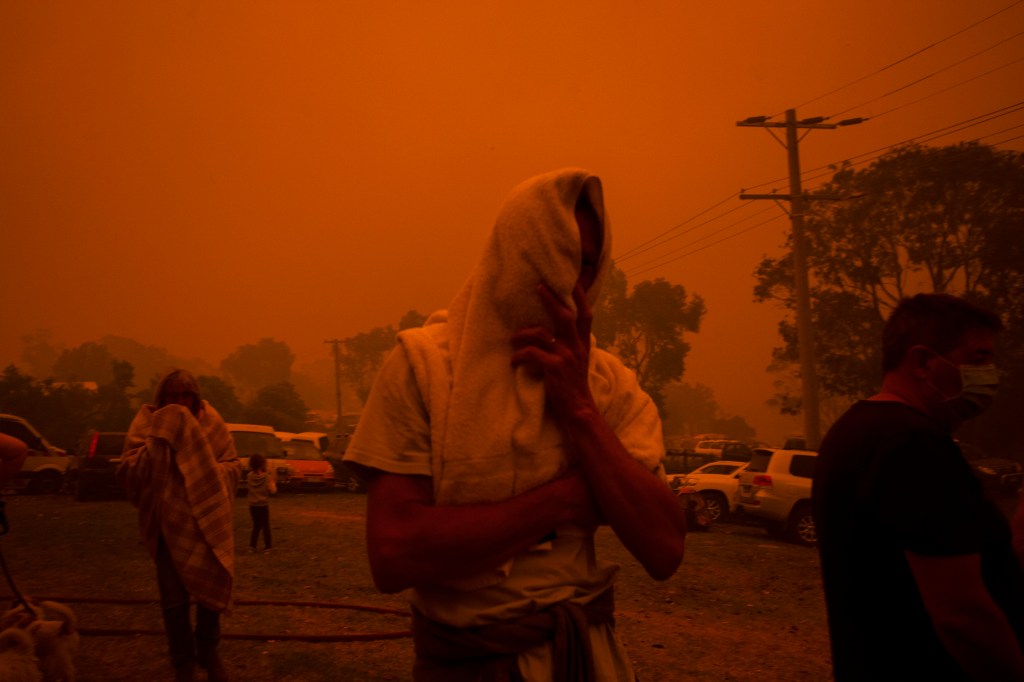
Vietnamese-French artist, Thu Van Tran’s Rainbow Herbicides 2018 recreate, in graphite drawings, the lethal cocktail of Agent Orange herbicides during the Vietnamese War in the 1960s. Additionally, Plume 20 2022, Pairrebeener-Australian Jemima Wyman’s vast cloud of air, was created from a collage of images depicting protest and civil unrest. It brings together images of flares, tear gas, water cannons, smoke and the acrid black fumes of burning tyres. George Floyd’s words, I can’t breathe, come all too vividly to mind in this extraordinary piece of art.
READ: WATER: QAGOMA (QLD)
Mexican artist, Carlos Amorales’ swarm of black moth and butterfly silhouettes entitled Black Cloud 2007/2018 is a stark reminder of the fragility of life and also of our human life cycle. An entire room is filled with cut-out black paper moths, lovingly crafted and arranged. Meanwhile, South Australian artist, Yhonnie Scarce’s native bush yams have been reimagined into hung curtains of blown glass. Cloud Chamber 2022 represents for her the nuclear testing and radioactivity at Maralinga in the 1950s where she was raised.
Change
Change gives us a wide sweep of challenging works – from Pakistan artist, Ali Kazim’s wall of dust in Untitled (storm series) to New Zealander, Patrick Pound’s rather whimsical sharing of knowledge through air.
Wiradjuri/Kamilaroi artists, Jonathan Jones and Dr Uncle Stan Grant Snr AM collaborated on the splendid untitled (giran) 2018, part of QAGOMA’s collection. With a haunting soundscape and some 2000 separate sculptures depicting birds and feathers, this is a monumental work that challenges us to view the world around us in different ways.
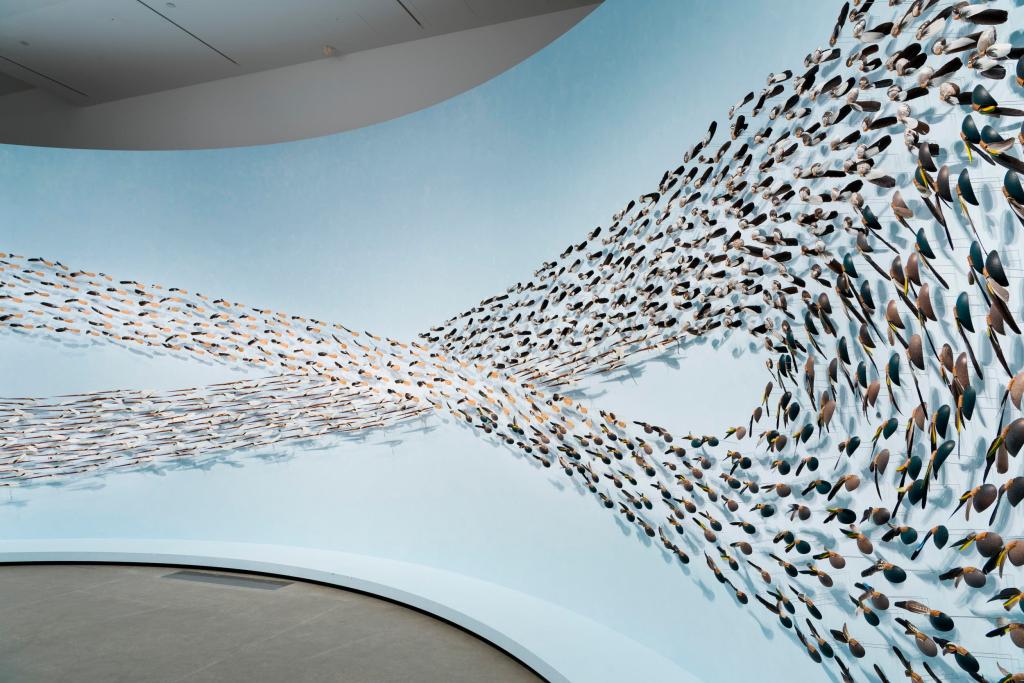
British artist and filmmaker Tacita Dean’s Chalk Fall 2018, continues the theme of climate issues in depicting a textural, multi-panel drawing, which in part evokes the falling of Dover’s chalk cliffs, recalling similar recent glacial images. While the British-American Anthony McCall’s solid-light installation Crossing 2016 impressively shows air becoming visible through shafts of light intersecting with smoke haze.
At times, it does seem that the five themes have distinctly blurred edges and that certain works could easily have fitted under many headings with several different resonances. Being nebulous, the subject of air itself has many connotations and interpretations. And Burn certainly brings us into the realm of fire, while Shared, with its defined emphasis on the natural world, has closer ties to earth.
Perhaps Fire and Earth will become exhibition topics for QAGOMA in the future? Certainly pollution, industrial degradation, climate issues, measuring air quality and the ability for the world’s population to be able to breathe fresh, clean air are all explored in this terrific exhibition through works that are as thought-provoking and engaging as they are aesthetically pleasing or disturbing.
Air runs at the Queensland Art Gallery | Gallery of Modern Art (QAGOMA) until April 23 2023 .
